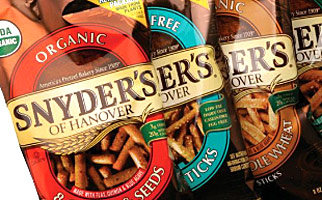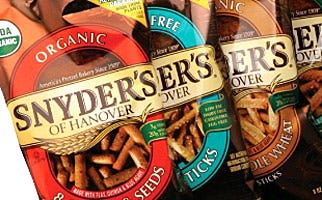Snyder’s of Hanover offers new twist on sustainable packaging


Snyder
Snyder’s of Hanover’s (headquartered in Hanover, PA) first foray into environmentally-conscious packaging hit stores in fall 2009. New 100-Calorie Pretzel Variety Sacks and Pretzel Sandwich Variety Packs are reportedly the first certified, fully compostable, outer retail package for multipack salted snacks. Each handle-bag package holds 22 single-serving pretzel packs (1 oz each). The total 1 lb 6 oz product retails for a suggested price of $7.49.
Made from a proprietary blend of natural starch-based polymers including PLA, the outer bag’s film is a 4.0-mil monolayer structure. The individual pretzel packs inside are a lamination of oriented PP/PE/oriented-PP films. A chasing-arrows logo on the front of the gusseted pouch reads: “This bag is made from 100 percent compostable, renewable material.” Explanatory copy on the back describes the bag’s environmental benefits and other sustainability efforts at Snyder’s, and features a prominent “Compostable” logo.
What prompted the decision to pursue bioplastics packaging? “Consumer packaging is just one element to our corporate sustainability initiative with stated goals of reducing energy, natural-gas and greenhouse-gas usage by 15 percent each year over the next five years as well as reducing our solid waste by over 30 percent over the next five years,” explains Claude O’Connor, vp of marketing at Snyder’s of Hanover.
“We wanted to expand our push toward a more sustainable business model with the introduction of this new product,” adds Mike Brookhart, Snyder’s director of marketing. (See sidebar, “Snyder’s ‘sustainability’ way of life.”)
Collaboration leads to breakthrough
Sourced and co-developed by Loveland, OH-based packaging supplies and equipment distributor xpedx, the outer packaging came to fruition through collaboration among Snyder’s partners: xpedx, DRP Flexpak, a flexible-packaging converter representative in Waterford, CT, and Gardner, MA-based converter Garlock Printing and Converting Corp.
Jeff Fisher, packaging account manager for xpedx Mid-Atlantic group, and DRP Flexpak owner Mike Meehan first reviewed several potential materials before narrowing the choice to the blended starch-based film. Over a three-month process, xpedx and Garlock then performed R&D trials (adding stiffening agents to the polymers) to determine the proper formulation for the best film texture, properties and thickness.
“The goal was to create a replacement for a traditional polybag,” Fisher explains. “We originally produced a material that did not have the desired structural characteristics, so we experimented with the formula and different manufacturing parameters. The final product has a matte finish and the feel of soft vinyl. The stiffening agents allow it to stand up and let the handle be die-cut; otherwise, it’s a very elastic material. The film has pretty good [oxygen and water-vapor] barriers.”
Conversion/packaging process
xpedx and Garlock designed the film for flexographic printing and downstream converting. Garlock’s capabilities include up to 10-color gearless printing, 7-color process printing, slitting, bag/pouchmaking and solventless laminating.
Garlock surface-flexo-prints the Pretzel Variety outer-bag film in eight colors, including line and process printing with water-based inks. Parent rolls are slit to size; then the film is run on a bagmaker to form the bottom gusset, die-cut the handle, side-weld the film and wicket the finished bags. “The starch in the films made it harder to print to the proper quality standards,” Fisher says. The single-serving packs are printed flexo as well.
“The project took a lot of work, trials and reconfigurations, but in the end it produced a high-quality printed piece that is the first of its kind for the snack-food market,” says Phil Ceryanek, co-owner of Garlock Printing and Converting.
The Pretzel Variety outer package meets stringent American Society for Testing and Materials (ASTM) specifications for organic compostable materials and third-party Biodegradable Products Institute (BPI) requirements for renewability and compostability. Certified 100-percent compostable by ASTM and BPI, the bag is printed using ASTMD-6400-certified flexo inks to ensure the final package is fully compostable.
On the Snyder’s of Hanover packaging line, a rotary band-seal bagger (supplied by xpedx) puts seals above and below the handle, reinforcing it in the process, after filling. The renewable film reportedly requires 35-percent less dwell time and a 35-percent lower temperature to seal on the bagmaking and packaging machinery than the typical 4-mil PE structure it was meant to replace. “It processes really fast and sets up very fast,” Fisher says.
Summing up the renewable-film packaging effort, Brookhart says, “xpedx did quite well on this project. They’re certainly one of our valued suppliers because they come to us with packaging expertise and new ideas.”
Product-to-package synergy
Launched to coincide with this year’s Earth Day (April 22), the second of Snyder’s green developments is a 90-percent plant-based, renewable flexible film. Three varieties of Snyder’s organic pretzel-stick line (Honey Whole Wheat, Whole Wheat & Oat, and 8 Grain & Seeds) and one SKU of its new Gluten-Free Pretzel Sticks are packed in the bioplastic film. A triangular, yellow graphic on the packages’ upper right corner touts the “Renewable Package Made From Plants,” and a back panel gives consumers further detail on the material’s eco benefits. The line is sold for a suggested retail price of $2.99 for an 8-oz bag. The full Gluten-Free line is expected to be available nationally by September.
“Our launch of this new plant-based packaging is just the latest example of our company’s commitment to utilizing products and practices that minimize negative effects on the environment,” says O’Connor. “It was important that we selected a product that complements the new renewable packaging, and our line of Organic Pretzel Sticks was a natural fit. It’s true product-to-packaging synergy.”
What were some of the challenges in finding the right bioplastic for the product line? “In addition to being able to run on our existing high-speed packaging lines, the materials needed to be able to provide the high-quality graphic printing as well providing similar barrier properties as traditional film material used in primary packaging,” O’Connor says. This was achieved through a customized multilayer-coextrusion lamination.
Snyder’s worked with Elk Grove Village, IL, converter Clear Lam Packaging Inc. to produce the finished material. It chose a proprietary EarthClear™ film from Clear Lam that is based primarily on Ingeo® PLA supplied by NatureWorks LLC. Produced at Clear Lam’s facility in Illinois, the Snyder’s multilayer structure is made of reverse-printed, biaxally oriented PLA film, mounted to metallized PLA film, which is then solventless-adhesive-laminated to a proprietary bioplastic coextrusion.
Compared to traditional petroleum-based films, the renewable raw materials for the Snyder’s film are reportedly produced with as little as half the energy and generate up to 48 percent fewer greenhouse-gas emissions in the manufacturing process, NatureWorks says.
All of the new Snyder’s renewable films for this application were flexographically printed at 1,200 ft/min. using 150-line-screen resolution, water-based inks and Clear Lam’s Expanded Gamut process. The converter offers up to 10-color printing on CI-flexo presses to meet customers’ on-pack requirements. Finished rolls are sent to Snyder’s of Hanover where they are run on proprietary high-speed, vertical form-fill-seal bagging equipment.
“Having the material be able to run on our current packaging lines with a minimum of modification was the challenge to our supplier,” explains Brookhart. “The biggest issue, which took several iterations to resolve, was having material with enough strength and/or elasticity to resist puncturing during the vertical-filling process.”
While the 22-count outer sack and Pretzel Sticks primary package were separate projects with each having its own set of issues, both were completed with supplier collaboration in a four- to six-month timeframe, Snyder’s says.
Compostable-bioplastic market sees strong growth
Following in the path of Frito-Lay and its 100-percent compostable SunChips® packaging, Snyder’s of Hanover’s effort represents another example of the high-growth business opportunity behind bioplastics of all types. According to Berlin, Germany, trade group European Bioplastics e.V., 2010 global production capacity of bioplastics will reach 588,000 metric tons. Seventy-two percent of that is compostable resins. The total bioplastics capacity is expected to roughly triple by 2013, with compostable types making up about half of the 1.46 million metric tons.
More information is available
xpedx, 513-965-2900. www.xpedx.com
DRP Flexpak, 800-321-4260. www.drpflexpak.com
Garlock Printing & Converting Corp., 978-630-1028. www.garlockprinting.com
Clear Lam Packaging, Inc., 847-439-8570. www.clearlam.com
NatureWorks LLC, 952-742-0400. www.natureworksllc.com
European Bioplastics e.V., +49-30-28482-350. www.european-bioplastics.com
.
About the Author(s)
You May Also Like


